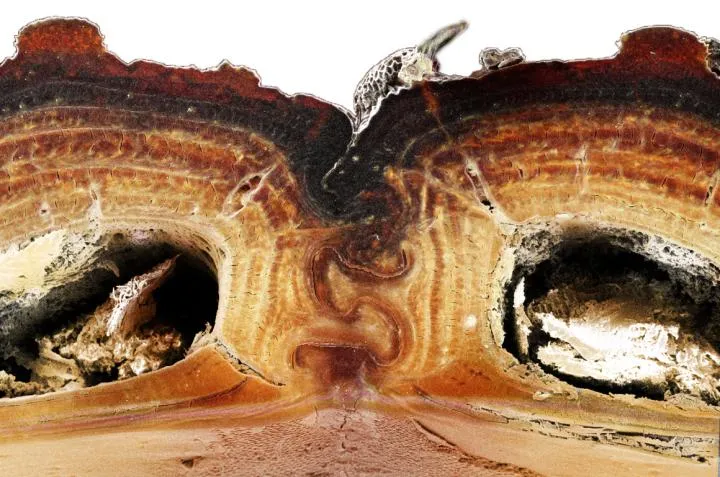The Secrets of the Diabolical Ironclad Beetle’s Almost Unsquishable Strength
Researchers hopped in a Toyota Camry and drove over the beetle twice…for science—and it survived
/https://tf-cmsv2-smithsonianmag-media.s3.amazonaws.com/filer/5e/b9/5eb9850f-698d-4b9a-a325-6699b35fffca/2020_oct22_diabolicalbeetle.png)
The diabolical ironclad is not a notorious Civil War-era battleship, but a flightless inch-long beetle that thrives on the United States’ west coast. While most beetles only live for a few weeks, a diabolical ironclad can live for seven or eight years, in part because it outer shell is so peck-, crunch- and squash-proof. Now, a new study has unraveled what makes the beetle so buff, Katherine J. Wu reports for the New York Times.
The paper, published on October 21 in the journal Nature, shows how the beetle’s exoskeleton uses internal layers, tight joints and overall near-indestructable shape to give it both toughness and flexibility under pressure. And by studying the beetle’s strategy’s, engineers may be able to apply the same techniques to synthetic materials used in aircraft and construction.
“These beetles are doing the beetle-equivalent of living for 1,000 years,” says Max Barclay, the Natural History Museum in London’s curator of beetles who wasn’t involved in the new study, to the Guardian’s Nicola Davis. “So they have to protect themselves against risk in a way that shorter-lived creatures don’t.”
While many beetles are rounded on top, the diabolical ironclad is flat and low to the ground, University of California, Irvine, materials scientist David Kisailus tells Science News’ Maria Temming. That makes it hard to squish, since the pressure is distributed over the whole shell. Compression experiments conducted by Kisailus and colleagues showed that the exoskeleton held up against up to the crushing force of 39,000 times the beetle’s body weight.

Getting run over by a car only exerted about two-thirds of that force on the beetle’s back, according to a statement. The researchers recorded the sedan experiment on video in 2015, capturing two rounds of a Toyota Camry driving directly over a diabolical ironclad beetle in a parking lot.
“Yeah, it’s still alive,” University of California, Riverside materials scientist Jesus Rivera, the first author on the paper, said in the video reviewed by the New York Times after one pass by the car. “It’s playing dead. But it’s still alive.”
The exoskeleton is also made of a super tough, layered material. The rock-hard shell has long plagued entomologists who can’t use their normal stainless-steel pins to mount the beetles in collection boxes. In order to pin up a beetle, insect collectors first need to drill holes in the shell where they want to put a pin, Matt Simon reports for Wired. The protein-rich layering of the exoskeleton seems to boost toughness because the layers can crackle and separate individually, without the entire shell breaking at once, per the Guardian.
The layers also work to distribute stress over the joints where different parts of the exoskeleton come together.
“You can imagine the beetle’s exoskeleton almost like two halves of a clamshell sitting on top of each other,” Kisailus tells Science News. The top piece and bottom piece join together like the two sides of a zipper, each piece zig-zagging into the other.
The top and bottom halves of the front end of the beetle are tightly stitched together, creating a rigid shield around the vital organs within. But at the beetle’s rear end, the top and bottom of the exoskeleton can shift in relation to each other. That means that when something tries to squish the beetle, the internal goo can mush toward the back of the beetle, relieving pressure on the vital organs in the front.
Another joint in the exoskeleton runs down the beetle’s back. There, the two pieces of ironclad shell join together like a jigsaw puzzle. Here, the layers are key. Usually, when pressure is put on something like a jigsaw puzzle piece, it would snap at the thinnest point: the neck of the puzzle nub. But because the shell’s layers follow along with the shape of the nub, any pressure is distributed around the jigsaw joint.
The beetle’s attributes—strength against impacts and resistance to shattering—would be useful in engineering things like body armor, buildings, bridges and aircraft. The point where two plates of material join together is often the weakest point in an impact, a problem that the interlocking pattern of layered jigsaw pieces may be able to solve.
Mechanical engineer Adriane Minori at the University of California, San Diego, tells the New York Times, “It’s a fail-safe mechanism that nature has found — that’s something we can learn from.”